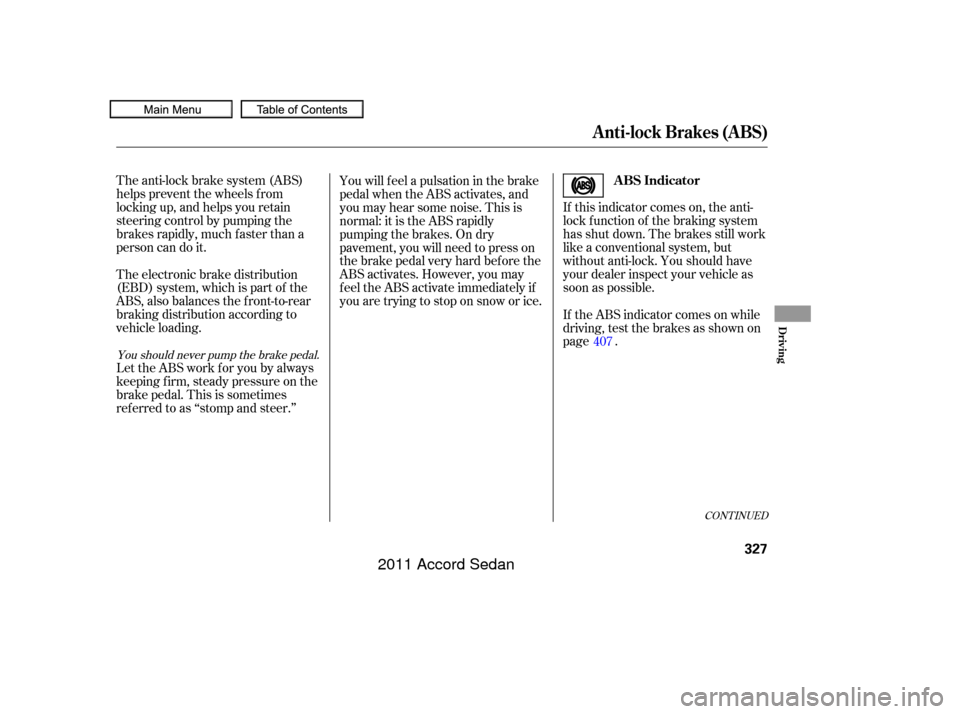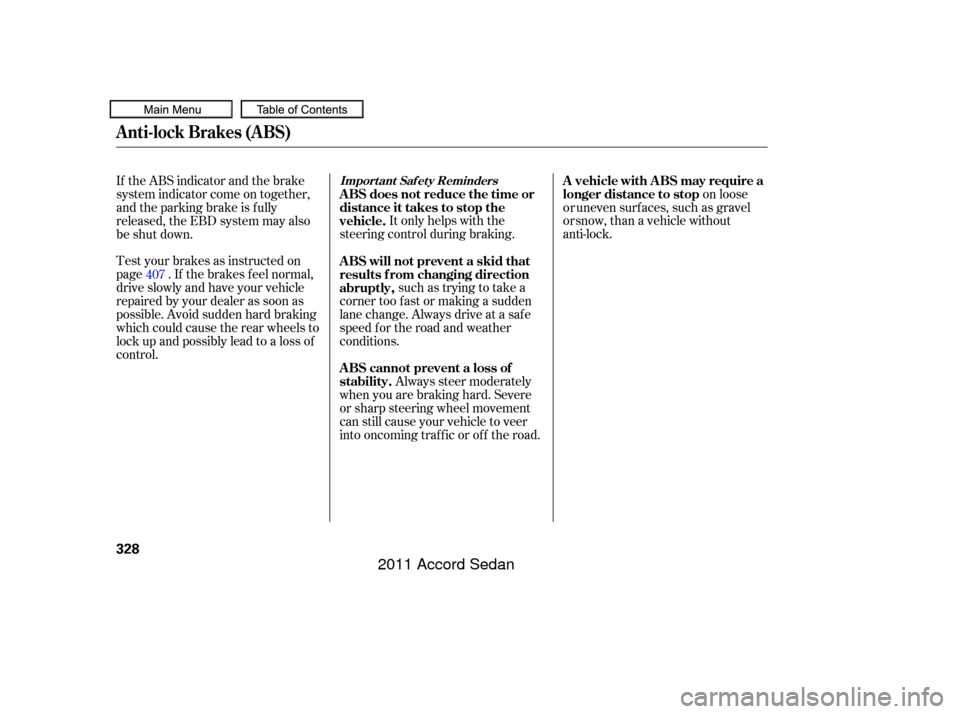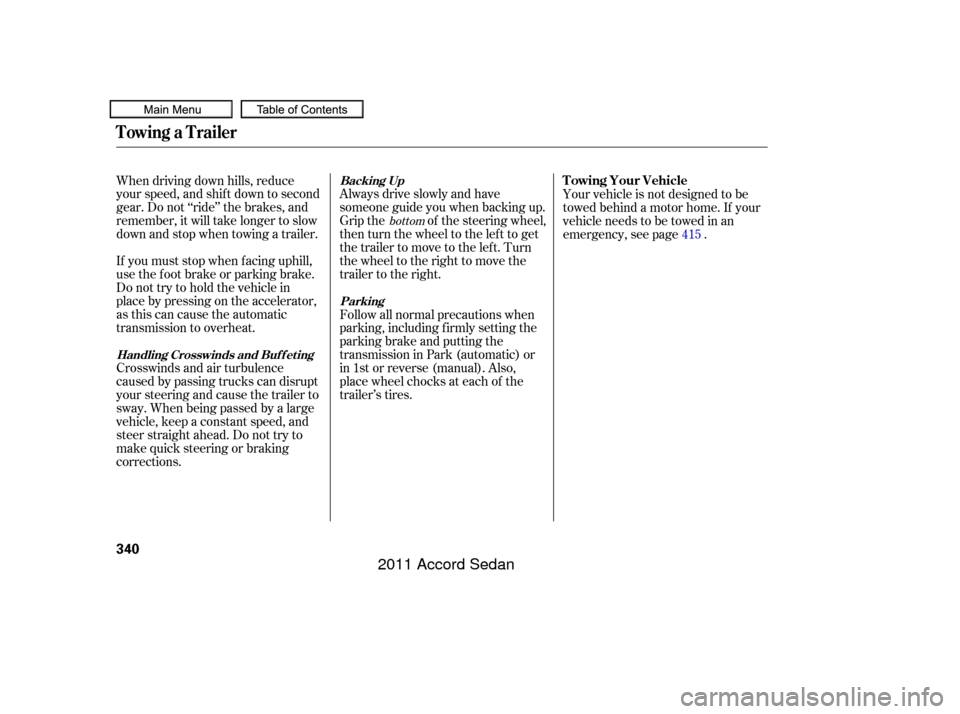Page 330 of 454

If this indicator comes on, the anti-
lock f unction of the braking system
has shut down. The brakes still work
like a conventional system, but
without anti-lock. You should have
your dealer inspect your vehicle as
soon as possible.
The anti-lock brake system (ABS)
helpspreventthewheelsfrom
locking up, and helps you retain
steering control by pumping the
brakes rapidly, much f aster than a
person can do it.
You will f eel a pulsation in the brake
pedal when the ABS activates, and
you may hear some noise. This is
normal: it is the ABS rapidly
pumpingthebrakes.Ondry
pavement, you will need to press on
thebrakepedalveryhardbeforethe
ABS activates. However, you may
feel the ABS activate immediately if
you are trying to stop on snow or ice.
The electronic brake distribution
(EBD) system, which is part of the
ABS, also balances the f ront-to-rear
braking distribution according to
vehicle loading.
Let the ABS work f or you by always
keeping f irm, steady pressure on the
brake pedal. This is sometimes
ref erred to as ‘‘stomp and steer.’’ If the ABS indicator comes on while
driving, test the brakes as shown on
page .
407
CONT INUED
You should never pump the brake pedal.
ABS Indicator
Anti-lock Brakes (ABS)
Driving
327
10/06/18 16:24:36 31TA5630_332
2011 Accord Sedan
Page 331 of 454

It only helps with the
steering control during braking.
such as trying to take a
corner too f ast or making a sudden
lane change. Always drive at a safe
speed f or the road and weather
conditions.
Always steer moderately
when you are braking hard. Severe
or sharp steering wheel movement
can still cause your vehicle to veer
into oncoming traffic or off the road. on loose
Test your brakes as instructed on
page . If the brakes f eel normal,
drive slowly and have your vehicle
repaired by your dealer as soon as
possible. Avoid sudden hard braking
which could cause the rear wheels to
lock up and possibly lead to a loss of
control. If the ABS indicator and the brake
system indicator come on together,
and the parking brake is f ully
released, the EBD system may also
be shut down. 407 A BS does not reduce the time or
distance it takes to stop the
vehicle.
A BS will not prevent a skid that
results f rom changing direction
abruptly,
A BS cannot prevent a loss of
stability. A vehicle with A BS may require a
longer distance to stop
Import ant Saf et y Reminders
Anti-lock Brakes (ABS)
328
10/06/18 16:24:42 31TA5630_333
anti-lock. or snow, than a vehicle without
or uneven surfaces, such as gravel
2011 Accord Sedan
Page 338 of 454
The maximum allowable weight of
the vehicle, all occupants, all
accessories, all cargo, and the
tongue load is:To achieve a proper tongue load,
start by loading 60% of the load
toward the front of the trailer and
40% toward the rear, then re-adjust
the load as needed.
Theweightthatthe
tongue of a f ully-loaded trailer puts
on the hitch should be approximately
10% of the total trailer weight. Too
much tongue load reduces f ront-tire
traction and steering control. Too
little tongue load can make the
trailer unstable and cause it to sway.
CONT INUED
EX and EX-L:
V6 models: EX
and EX-L:
V6 models:
LX, LX-P andSE: SE:
Towing a Trailer
Gross Vehicle Weight Rating
(GVWR):
Tongue Load: U.S. modelsCanadian models
Driving
335
4,575 lbs (2,075 kg) 4,431 lbs (2,010 kg)
4,299 lbs (1,950 kg)1,970 kg
2,030 kg
2,090 kg
10/06/18 16:25:36 31TA5630_340
2011 Accord Sedan
Page 343 of 454

Always drive slowly and have
someone guide you when backing up.
Grip the of the steering wheel,
then turn the wheel to the left to get
the trailer to move to the lef t. Turn
the wheel to the right to move the
trailer to the right.
When driving down hills, reduce
your speed, and shif t down to second
gear. Do not ‘‘ride’’ the brakes, and
remember, it will take longer to slow
downandstopwhentowingatrailer.
If you must stop when f acing uphill,
use the f oot brake or parking brake.
Do not try to hold the vehicle in
placebypressingontheaccelerator,
as this can cause the automatic
transmission to overheat. Your vehicle is not designed to be
towed behind a motor home. If your
vehicle needs to be towed in an
emergency, see page .
Crosswinds and air turbulence
caused by passing trucks can disrupt
your steering and cause the trailer to
sway. When being passed by a large
vehicle, keep a constant speed, and
steer straight ahead. Do not try to
make quick steering or braking
corrections. Follow all normal precautions when
parking, including f irmly setting the
parking brake and putting the
transmission in Park (automatic) or
in 1st or reverse (manual). Also,
place wheel chocks at each of the
trailer’s tires. 415
bottom
Backing Up
Parking
Handling Crosswinds and Buf f et ing
Towing Your Vehicle
Towing a Trailer
340
10/06/18 16:26:19 31TA5630_345
2011 Accord Sedan
Page 344 of 454

This section explains why it is
important to keep your vehicle well
maintained and how to f ollow basic
maintenance saf ety precautions.
This section also includes
instructions on how to read the
Maintenance Minder messages on
the information display, and
instructions f or simple maintenance
tasks you may want to take care of
yourself .
If you have the skills and tools to
perf orm more complex maintenance
tasks on your vehicle, you may want
to purchase the service manual. See
page f or inf ormation on how to
obtain a copy, or see your dealer.U.S. Vehicles:
......................
Maintenance Saf ety .342
.................
Maintenance Minder . 343
..............................
Fluid Locations .350
........................
Adding Engine Oil .352
Changing the Engine Oil and ...........................................
Filter .354
..............................
Engine Coolant .356
....................
Windshield Washers .358
.......................
Transmission Fluid .359
..........
Automatic Transmission . 359
..............
Manual Transmission . 361
................
Brake and Clutch Fluid . 362
................................
Brake Fluid .362
...............................
Clutch Fluid .363
....................
Power Steering Fluid . 363
....................................
Timing Belt .364
.............................................
Lights .365
................
Cleaning the Seat Belts . 375
.....................................
Floor Mats .375
..................
Dust and Pollen Filter . 376
.................................
Wiper Blades .377
...............................................
Tires .380
...................
Checking the Battery . 388
.............................
Vehicle Storage .389
..................................
Interior Care .390
439
Maintenance
Maintenance, replacement, or
repair of emissions control
devices and systems may be done
by any automotive repair
establishment or individual using
parts that are ‘‘certif ied’’ to EPA
standards.
Maint enance
341
TM
10/06/18 16:26:24 31TA5630_346
2011 Accord Sedan
Page 352 of 454

�Î
�Î
�Ì �Ì
�µ
�µ
�Î
�Ì
Maintenance Minder
349
Maintenance Main Items
Replace engine oil
Replace engine oil and oil filter
Inspect front and rear brakes
Check parking brake adjustment
Inspect these items: Tie rod ends, steering gear box, and boots
Suspension components
Driveshaft boots
Brake hoses and lines (including ABS/VSA)
All fluid levels and condition of fluids
Exhaust system
Fuel lines and connections Maintenance Sub Items
Rotate tires
Replace air cleaner element
Replace dust and pollen filter
Inspect drive belt
Replace transmission fluid
Replace spark plugs
Replace timing belt and inspect water pump
(V6 engine only)
Inspect valve clearance
Replace engine coolant
A
B
Symbol
1
2
3
4
5
Symbol1
1
:
Inspect idle speed every 160,000 miles (256,000 km).
Adjust the valves during services A, B, 1, 2, or 3 only if they are noisy.
If the message ‘‘SERVICE’’ does not appear more than 12 months after the
display is reset, change the engine oil every year.
See information on maintenance and emissions warranty in the center
column on page .
Independent of the Maintenance Minder information, replace the brake
fluid every 3 years.
NOTE: 1:
348
TM
If you drive in dusty conditions, replace every 15,000
miles (24,000 km).
If you drive primarily in urban areas that have high
concentrations of soot in the air from industry and from
diesel-powered vehicles, replace every 15,000 miles
(24,000 km).
If you drive regularly in very high temperatures (over
110°F, 43°C), or in very low temperatures (under 20°F,29°C), replace every 60,000 miles (U.S.)/100,000 km
(Canada).
Maintenance Minder
10/06/18 16:27:31 31TA5630_354
2011 Accord Sedan
Page 353 of 454
Fluid Locations
4-cylinder models
350
CLUTCH FLUID
(Manual
Transmission only)
(Light gray cap)
AUTOMATIC
TRANSMISSION
FLUID DIPSTICK
(Yellow loop)
BRAKE FLUID
(Black cap)
ENGINE OIL DIPSTICK
(Orange handle)
POWER STEERING FLUID
(Red cap)
RADIATOR CAP ENGINE COOLANT
RESERVOIR
ENGINE OIL FILL CAP
WASHER FLUID
(Blue cap)
10/06/18 16:27:35 31TA5630_355
2011 Accord Sedan
Page 354 of 454
Fluid Locations
V6 models
Maint enance
351
BRAKE FLUID
(Black cap)
RADIATOR CAP
ENGINE OIL DIPSTICK
(Orange loop)
POWER STEERING FLUID
(Red cap)
WASHER FLUID
(Blue cap)
ENGINE COOLANT
RESERVOIR
ENGINE OIL FILL CAP
AUTOMATIC
TRANSMISSION
FLUID DIPSTICK
(Yellow loop)
10/06/18 16:27:39 31TA5630_356
2011 Accord Sedan